It looks like you're using an Ad Blocker.
Please white-list or disable AboveTopSecret.com in your ad-blocking tool.
Thank you.
Some features of ATS will be disabled while you continue to use an ad-blocker.
share:
Ok found away around PB's lame new software
So here's the images I was going to post earlier.
The San Joaquin Valley
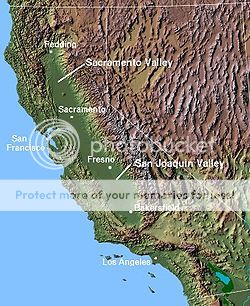
Lake tulare

The megafauna

This image shows some of the animals running around here 15000 years ago
So here's the images I was going to post earlier.
The San Joaquin Valley

Lake tulare

The megafauna

This image shows some of the animals running around here 15000 years ago
Back to the Clovis people and their beautifully crafted points.




The range of the Clovis people.

Until recently it was assumed that Clovis was first, then a series of finds threw that idea into flux.
One is the topped site in South Carolina
en.m.wikipedia.org...(archaeological_site)#section_1
The meadowcroft rock shelter is another
en.m.wikipedia.org...




The range of the Clovis people.

Until recently it was assumed that Clovis was first, then a series of finds threw that idea into flux.
One is the topped site in South Carolina
Text Topper is an archaeological site located along the Savannah River in Allendale County, South Carolina in the United States. It is noted as the location of controversial artifacts believed by some archaeologists to indicate human habitation of the New World earlier than the Clovis culture, previously believed to be the first people in North America. Artifacts at this site may predate Clovis by 3,000 years or more. The primary excavation has gone down to the 50,000 B.C. level, searching for any other archaeological evidence. Until increasing challenges in the first decade of the 21st century to the Clovis theory based on this site and others, it was unusual for archaeologists to dig deeper than the layer of the Clovis culture, as they then believed that no human artifacts would be found older than Clovis.
Among the objects from the "pre-Clovis" stratum dated to 16,000-20,000 years BP, this "Topper Chopper" offers some of the most compelling evidence for human agency. Aside from the bifacial flaking of the edge, this simple implement, although badly weathered, still clearly displays the classic zoomorphic features repeatedly appearing in the material first recognized in 1987 at 33GU218 in Ohio and, not surprisingly, many other locations that have since come to light. The object possesses a typical overall abstract bird form and two very characteristic features consistently deeply carved into such figures: a mouth cut in the form of a bird facing inward, and a diamond-shaped eye. It is also significant that the figure incorporates "reflectional symmetry", a hallmark of human agency, in that the image is repeated (although not as distinctly in this case) on the opposite side of the rock. And its flat base allows the figure to stand upright. The general form of this stone is a very common one both in North American artifact material and in European artifacts dating from the Paleolithic. [1]
en.m.wikipedia.org...(archaeological_site)#section_1
The meadowcroft rock shelter is another
Meadowcroft Rockshelter is an archaeological site located near Avella in Jefferson Township, Washington County, in southwestern Pennsylvania, United States. The site, a rock shelter in a bluff overlooking Cross Creek (a tributary of the Ohio River), is located 27 miles west-southwest of Pittsburgh [3] in the Pittsburgh metropolitan area. The site, including a museum and recreation of an 18th-century village, is operated by the Heinz History Center. The artifacts from the site show the area has been continually inhabited for 16,000 years, since Paleo-Indian times. The Rockshelter was named a National Historic Landmark in 2005. It is also recognized as a Pennsylvania Commonwealth Treasure and is an official project of Save America's Treasures.
en.m.wikipedia.org...
edit on 7-12-2012 by punkinworks10 because: (no reason given)
Aside from the sites that have a pre Clovis layer, new finds on the west coast have proven there was another culture in NA that contemporaneous with
Clovis.
First is paisley cave in eastern Oregon.
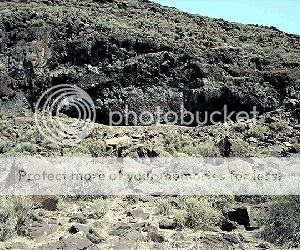
en.m.wikipedia.org...
Many signs of habitation and fossilized poo have been found in paisley caves.
m.sciencemag.org...
Them there is the finds on the channel islands off of California
First is paisley cave in eastern Oregon.

A field school from the University of Oregon has been examining the site since 2002 and analyzing its pre-Clovis artifacts. [1] In the summer of 2007, they identified the oldest human DNA yet discovered in the American continents. This assertion is based on several samples of coprolite (fossilized excrement) found in the Paisley Caves complex, between Lakeview and Bend, Oregon, on the eastern side of the Cascade mountain range. [2][3][4] Since then, other authors have questioned the authenticity of these findings by arguing about the relevance of the evidence gathered from ancient DNA and stratigraphy on the one hand, [5] and from the morphological assignment of the coprolites to humans on the other. [6]
The fossils were found in Paisley Five Mile Point Cave at the same level as a small rock-lined hearth some 7 feet (2 m) below the modern surface. At that level was also discovered a large number of bones from waterfowl, fish, and large mammals including extinct camel and horse. Radiocarbon dating places these coprolites between 12,750 and 14,290 calendar years before the present, probably representing a pre-Clovis occupation. DNA analysis provides apparent genetic ties to Siberia or Asia. [7]
Evidence at other archaeological sites — as well as 1930s work at Paisley Caves — had also been thought to provide such evidence, but questionable excavation techniques clouded the issue. Knowing this, the U of O team worked carefully to avoid the mistakes of the past. [1] The theory that pre-Clovis immigrants traveled to North America down the Pacific Coast suggests that the travelers would have passed through the hinterlands of what is Oregon today. The Paisley Caves, up-river from the Pacific Ocean along the Klamath River, are therefore an ideal spot to search for the evidence of such people. The fossils provide evidence of the groups possibly having lived there. DNA from coyote, fox, and dog (or wolf) were also found. [8]
Hunting tools were later found in the caves. [9][10][11]
The caves are in the Summer Lake basin at 4,520 feet (1,380 m) elevation and face to the west in a ridge of Miocene and Pliocene era basalts mixed with soft volcanic tuffs and breccias from which the caves were carved by Pleistocene era waves from Summer Lake. The caves are located north of the city of Paisley, Oregon. [8][12]
en.m.wikipedia.org...
Many signs of habitation and fossilized poo have been found in paisley caves.
The Paisley Caves in Oregon record the oldest directly dated human remains (DNA) in the Western Hemisphere. More than 100 high-precision radiocarbon dates show that deposits containing artifacts and coprolites ranging in age from 12,450 to 2295 14 C years ago are well stratified. Western Stemmed projectile points were recovered in deposits dated to 11,070 to 11,340 14 C years ago, a time contemporaneous with or preceding the Clovis technology. There is no evidence of diagnostic Clovis technology at the site. These two distinct technologies were parallel developments, not the product of a unilinear technological evolution. “Blind testing” analysis of coprolites by an independent laboratory confirms the presence of human DNA in specimens of pre-Clovis age. The colonization of the Americas involved multiple technologically divergent, and possibly genetically divergent, founding groups.
m.sciencemag.org...
Them there is the finds on the channel islands off of California
Smithsonian Institution scholars describes the discovery of scores of stemmed projectile points and crescents dating to that time period. The artifacts are associated with the remains of shellfish, seals, geese, cormorants and fish. Funded primarily by grants from the National Science Foundation, the team also found thousands of artifacts made from chert, a flint-like rock used to make projectile points and other stone tools. Some of the intact projectiles are so delicate that their only practical use would have been for hunting on the water, said Jon Erlandson, professor of anthropology and director of the Museum of Natural and Cultural History at the University of Oregon. He has been conducting research on the islands for more than 30 years. "This is among the earliest evidence of seafaring and maritime adaptations in the Americas, and another extension of the diversity of Paleoindian economies," Erlandson said. "The points we are finding are extraordinary, the workmanship amazing. They are ultra thin, serrated and have incredible barbs on them. It's a very sophisticated chipped-stone technology."
Continuing,
www.sciencedaily.com...
Western stemmed points
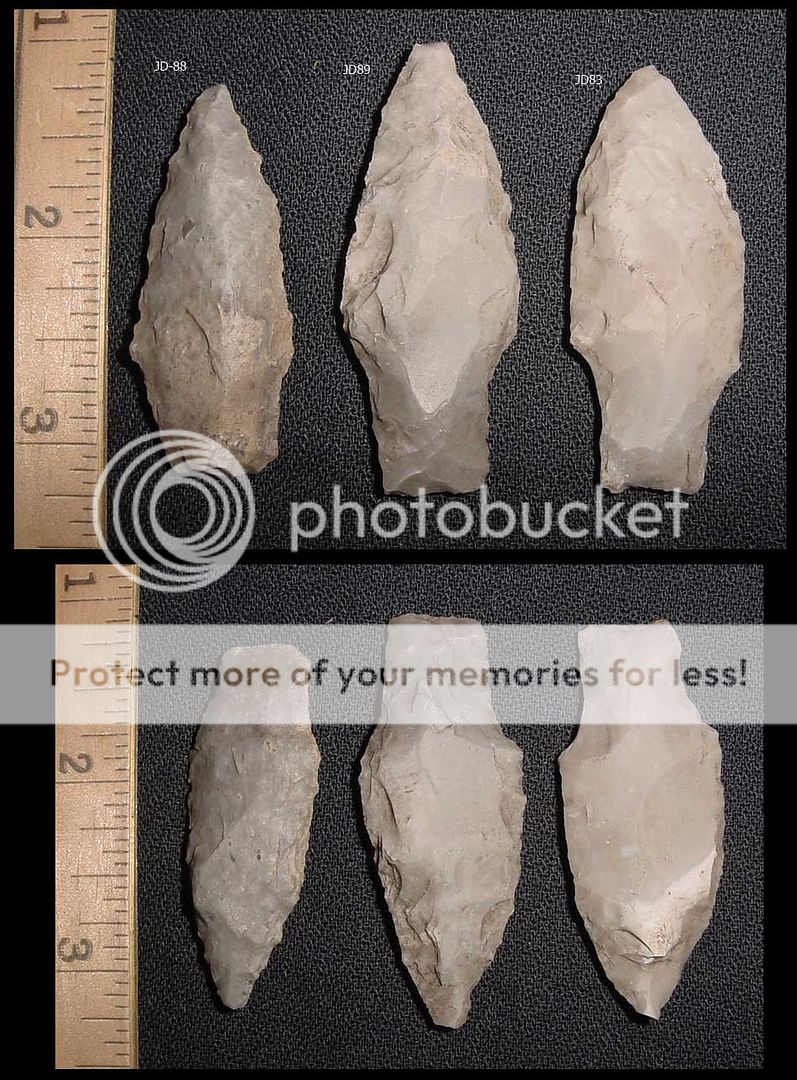
A cresent from Santa Rosa island
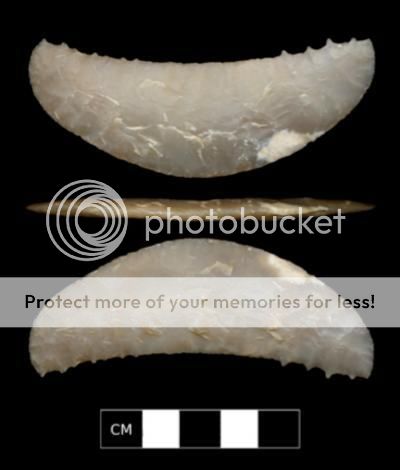
A cresent from a little k.ow California site , that I will get onto later.
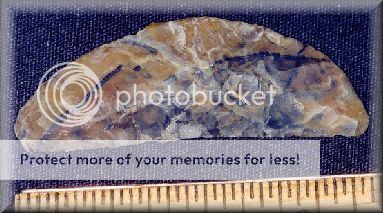
And another tool called a humpie from that same California site
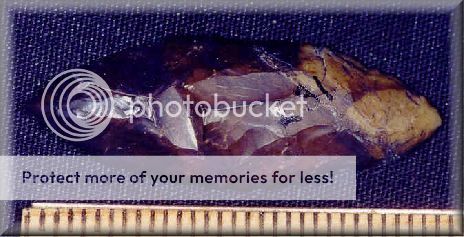
I seems to be clear that the people who made stemmed points and cresents and settled along the west coast ate different from the Clovis.
Here is a l
The technologies involved suggest that these early islanders were not members of the land-based Clovis culture, Erlandson said. No fluted points have been found on the islands. Instead, the points and crescents are similar to artifacts found in the Great Basin and Columbia Plateau areas, including pre-Clovis levels at Paisley Caves in eastern Oregon that are being studied by another UO archaeologist, Dennis Jenkins. Last year, Charlotte Beck and Tom Jones, archaeologists at New York's Hamilton College who study sites in the Great Basin, argued that stemmed and Clovis point technologies were separate, with the stemmed points originating from Pacific Coast populations and not, as conventional wisdom holds, from the Clovis people who moved westward from the Great Plains. Erlandson and colleagues noted that the Channel Island points are also broadly similar to stemmed points found early sites around the Pacific Rim, from Japan to South America.
www.sciencedaily.com...
Western stemmed points

A cresent from Santa Rosa island

A cresent from a little k.ow California site , that I will get onto later.

And another tool called a humpie from that same California site

I seems to be clear that the people who made stemmed points and cresents and settled along the west coast ate different from the Clovis.
Here is a l
Continuing,
www.sciencedaily.com...
Western stemmed points

A cresent from Santa Rosa island

A cresent from a little k.ow California site , that I will get onto later.

And another tool called a humpie from that same California site

I seems to be clear that the people who made stemmed points and cresents and settled along the west coast ate different from the Clovis.
Here is a link to a discussion on the genetic difference of the two people, and other implications of the finds at paisley.
s anthropogenesis.kinshipstudies.org...
The technologies involved suggest that these early islanders were not members of the land-based Clovis culture, Erlandson said. No fluted points have been found on the islands. Instead, the points and crescents are similar to artifacts found in the Great Basin and Columbia Plateau areas, including pre-Clovis levels at Paisley Caves in eastern Oregon that are being studied by another UO archaeologist, Dennis Jenkins. Last year, Charlotte Beck and Tom Jones, archaeologists at New York's Hamilton College who study sites in the Great Basin, argued that stemmed and Clovis point technologies were separate, with the stemmed points originating from Pacific Coast populations and not, as conventional wisdom holds, from the Clovis people who moved westward from the Great Plains. Erlandson and colleagues noted that the Channel Island points are also broadly similar to stemmed points found early sites around the Pacific Rim, from Japan to South America.
www.sciencedaily.com...
Western stemmed points

A cresent from Santa Rosa island

A cresent from a little k.ow California site , that I will get onto later.

And another tool called a humpie from that same California site

I seems to be clear that the people who made stemmed points and cresents and settled along the west coast ate different from the Clovis.
Here is a link to a discussion on the genetic difference of the two people, and other implications of the finds at paisley.
s anthropogenesis.kinshipstudies.org...
I think the evidence is pretty clear that Clovis and western stemmed points represent completley different people, with the western stemmed people
being ancestral to the inland native Americans. The travelled up the rivers into the continent following the steelhead and salmon, and settling all of
the western drainages. They penetrated deep into the continent via the Columbia river system and were also the ancestors of people of the great basin,
the shoshone,ute, paiute and eventually making it all the way to Mexico, in the form of the mexica or aztecs.
There is some circumstantial genetic evidence that the people who came into north America via the land bridge were of multiple ethnicities. A caucasoid central Asian people( siberians) who had spread into the tundra and arctic by at least 35k years ago. And a asiatic Mongolian people who were related to the people of the western stemmed tradition. There are antecedents to the western stemmed points in Asia.
The central Asian people were already a specialized society, depending almost entirely on big game to provide their life needs. They followed the animals deep into eastern north America and became the Clovis.
So if the geneticists are right that means the Clovis would have been ethnically very different from the other people here at the time.
Around 11,000 bce the Clovis culture went into decline, and ultimately dissapears in north America. The orthodox view is that Clovis hunted all of the large animals to extinction, an entire continents worth in just a few thousand years. That decline coincided with the onset of the younger dryas event, where average temperatures dropped by 20 degrees.
So loss of habitat and overhunting could account for the demise of the mega fauna.
Enter the younger dryas impact, scientists have proposed that a comet broke over north America and caused the extinction of the animals and the dissapearance if the Clovis people.
The debate over the impact theory has been contentious, with people trying to refute the idea. A new study published in Pnas adds more evidence to the theory, by reporting that signs of impact were discovered at the topper Clovis level.
articles.latimes.com...
There is some circumstantial genetic evidence that the people who came into north America via the land bridge were of multiple ethnicities. A caucasoid central Asian people( siberians) who had spread into the tundra and arctic by at least 35k years ago. And a asiatic Mongolian people who were related to the people of the western stemmed tradition. There are antecedents to the western stemmed points in Asia.
The central Asian people were already a specialized society, depending almost entirely on big game to provide their life needs. They followed the animals deep into eastern north America and became the Clovis.
So if the geneticists are right that means the Clovis would have been ethnically very different from the other people here at the time.
Around 11,000 bce the Clovis culture went into decline, and ultimately dissapears in north America. The orthodox view is that Clovis hunted all of the large animals to extinction, an entire continents worth in just a few thousand years. That decline coincided with the onset of the younger dryas event, where average temperatures dropped by 20 degrees.
So loss of habitat and overhunting could account for the demise of the mega fauna.
Enter the younger dryas impact, scientists have proposed that a comet broke over north America and caused the extinction of the animals and the dissapearance if the Clovis people.
The debate over the impact theory has been contentious, with people trying to refute the idea. A new study published in Pnas adds more evidence to the theory, by reporting that signs of impact were discovered at the topper Clovis level.
At each site he found the same microscopic spherules, which are the diameter of a human hair and distinct in appearance. He describes their look as tiny black ball bearings with a marred surface pattern that resulted from being crystalized in a molten state and then rapidly cooled. His investigation also confirmed that the spherules were not of cosmic origin but were formed from earth materials due to an extreme impact. LeCompte said it was Topper and Goodyear's collaboration, however, that yielded the most exciting results. "What we had at Topper and nowhere else were pieces of manufacturing debris from stone tool making by the Clovis people. Topper was an active and ancient quarry at the time," LeCompte said. "Al Goodyear was instrumental in our approach to getting samples at Topper." Goodyear showed LeCompte where the Clovis level was in order to accurately guide his sampling of sediments for the Younger Dryas Boundary layer. He advised him to sample around Clovis artifacts and then to carefully lift them to test the sediment directly underneath. "If debris was raining down from the atmosphere, the artifacts should have acted as a shield preventing spherules from accumulating in the layer underneath. It turns out it really worked!" Goodyear said. "There were up to 30 times more spherules at and just above the Clovis surface than beneath the artifact
articles.latimes.com...
edit on 7-12-2012 by punkinworks10 because: (no reason given)
I have to admit when I started this thread I had a plan, but as I compiled more info my views have changed and that plan went by the wayside. But I'm
now back on track with a revised idea.
So I think I established that there were two distinct cultures in north America at the onset of the younger dryas.
The big game hunting and nomadic Clovis, and the semi sedintary coastal people of the western stemmed tradition. It is thought that the people who came down the coast penetrated inland via the river basins, this idea is re-enforced by the paisley cave finds, paisley cave is at the head waters of the klammath river which drains into the pacific. These people are also thought to be the ancestors of the native Americans of the great basin and certain coastal california people, such as the chumash.
You might ask what does all this have to do with the central valley of California, well when I was researching stuff I ran across a little known Clovis site in California.
Enter the Far point site in Malibu , during residential construction a state archeologists noticed something.
And the author brings up the soultrean hypothosis,
So I think I established that there were two distinct cultures in north America at the onset of the younger dryas.
The big game hunting and nomadic Clovis, and the semi sedintary coastal people of the western stemmed tradition. It is thought that the people who came down the coast penetrated inland via the river basins, this idea is re-enforced by the paisley cave finds, paisley cave is at the head waters of the klammath river which drains into the pacific. These people are also thought to be the ancestors of the native Americans of the great basin and certain coastal california people, such as the chumash.
You might ask what does all this have to do with the central valley of California, well when I was researching stuff I ran across a little known Clovis site in California.
Enter the Far point site in Malibu , during residential construction a state archeologists noticed something.
The Farpoint Site (State of California formal designation: CA-LAN-451), is a recent and major archaeological discovery in California. The exciting discovery at the site was a Clovis projectile point (spearhead). The point was miraculously saved by Mr. Edgar Perez, Native American Cultural Resources Specialist, while he was monitoring a backhoe excavating a trench for a new mansion development on Point Dume. We knew we had a major find but we didn't know how major until we closely examined the specimen in our laboratory. It was noticed that the stone point did not fit the local archaeological record. Instead its precise overall shape, its slightly concave base and the fact that it had "fluted flakes" detached from its base, were all attributes indicating that the point belonged to the Clovis Culture. The Clovis Culture is the oldest identifiable culture in the New World. The name derives from the town of Clovis, New Mexico where the first Clovis site was found. Not being Clovis experts ourselves, we had the point examined by the foremost Clovis expert scholars around the country (including Prof. Vance Haynes, Univ. of Arizona; Professor Bruce Huckell, Director of the Maxwell Museum of Anthropology at the Univ. of New Mexico, and Prof. Don Johnson, Univ. of Illinois). Also Dr. Dennis Stanford, Chief Archaeologist at the Smithsonian, not only confirmed the find as Clovis, but states the unique status of the Farpoint Site in the Americas (see his quotes below). The Clovis Culture dates from about 11,500 Before Present to possibly as late as 11,000 years ago. It is also the widest spread of any ancient culture in the New World, ranging from Canada to Venezuela and from the U.S. eastern seaboard to the west, with the Farpoint site being the first discovery of a Clovis Site with a subsurface imbedded point at "continent's end," on the dramatic Point Dume along the Malibu coast. The world of the time Clovis was the late Ice Age (Pleistocene Epoch), one with many glaciers, frigid landscapes and ice-cold rivers and waterways. Ancient Clovis People used their distinctive Clovis Points to hunt the "megafauna" (or big game) of the Late Pleistocene, game such as the large mammoths, mastodons and extinct bison
And the author brings up the soultrean hypothosis,
There are two theories for the origins of the Clovis Culture. The traditional theory is that Clovis represents ancient Native Americans who immigrated across the Bering Land Bridge, between Siberia and Alaska and from there they made their way ever south until both North and South America were inhabited. However, according to Dr. Dennis Stanford, there are no antecedents for the Clovis spearheads in Asia whereas there are in ancient Europe. Therefore he believes Clovis people originated from the Solutrean Culture of what is now Spain and France, and coursing their way on boats along the coastlines of northwest Europe and then westward around Iceland, Greenland, to Nova Scotia, then southward along the Atlantic seaboard until they reached what is now the SE United States. From there Clovis proliferated and expanded westward, inhabiting virtually every State, until the Farpoint Site was reached at Continent's end. Dr. Stanford told me, however, that if we obtained a radiocarbon date earlier than the Clovis sites in the eastern U.S., he might have to revise his theory. That's how important the Farpoint Site is. Also if we were to find even one human tooth of the Clovis from Farpoint, we could do mitochondrial DNA analysis of it and see if there is a genetic match indicating which theory would appear to be correct. I also want to mention that we have already obtained (in 2000) a radiocarbon date of 9,000 years ago, which made Farpoint the oldest site in the City of Malibu at that time. Dr. Stanford believes Farpoint will date to 11,000 years ago or to the time of terminal Clovis.
www.farpointsite.blogspot.com...
The far point point
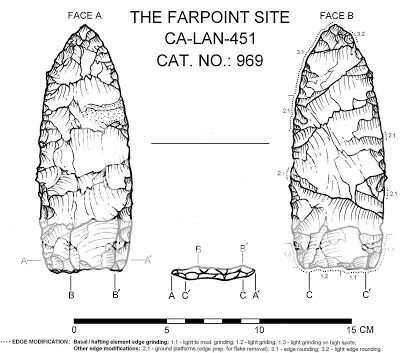
The most interesting thing about the site is that I lies below a historic chumash site.
If we hold to the kelp highway theory then the chumash should be descended from the western stemmed tradition, but here we have a site that has been inhabited deep into antiquity, by two different cultures.
Like the farpoint author questions what is the relationship between these two seemingly diverse people, one a generalist coastal forager, the other a specialized big game hunter society.
Well I go back to the great tulare lake in the central valley and the Witt Clovis site on the south west shore.
In the early sixties a farmer discovered a remarkably preserved Clovis point..

In subsequent studies it was found that the site had sings of human occupation going back more than
15000 years. Most importantly the site has western stemmed points and Clovis in assocpiation with each other.
And there is a pre Clovis/ western stemmed layer at the deepest levels, with human remains more than 15000 years old . Also more importantly there is a chipped bone tool technology at the deepest layers.
One of the Clovis sticking points is that there is no site where there is pre Clovis technology, which makes sense if they were nomadic. But here in cali we have a site who's dated stratigraphy clearly indicates a pre Clovis technology.
The site shows the traces of the maritime western stemmed tradition in the abundance of waterfowl and fish and shellfish remains and thier distinctive cresents.
These are cresents found at the Witt site

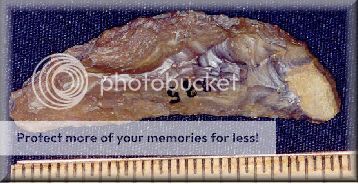
Compare to a cresent found on a channel island.

There has been much discussion on the purpose of the cresents, my take is the cresents are two distinct different tools, one is a waterfowl specific projectile point, the other is small hand sickle for harvesting the ubiquitous Tule reeds found along the tulare lake.
But we also have the big game tradition of the Midwest represented by the Clovis point and humpies.
This is a humpie found at the witt site

And
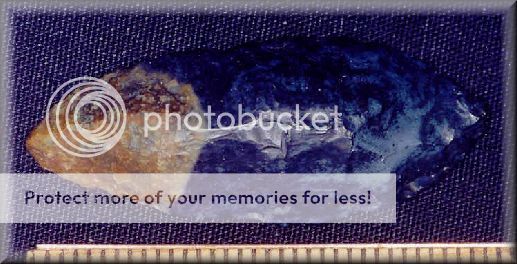
These are made from fire hardened chert only available several days walk towards coast.
Humpies are thought to be a general purpose scraper/woodworking tool, they have been found at Clovis sites all through north America.
A pdf on humpies from the Witt site
www.scahome.org...
And a study on pleistocene fishes of the san Joaquin drainage that has the only info I could find on the witt site.
www.ucmp.berkeley.edu...
When I first started this post my initial idea was that the Yokuts were the product of this combination of cultures, but know I belive that not only the yokuts but the chumash as well are descended from this group.
You see if you travel west up the canyon that drains the coast range into the tulare lake basin you will pass through the last habitable region for a hundred miles. El gato creek canyon cuts through the eastern coast range to the inland san benito river valley from there its short hike across the next arid valley to the lush coast range. This route will take you to the very precipitous central coast, but its only a few day walk to the northern part of the chumas territory, the vast and productive beaches of pismo and Santa Maria.
Pismo beach

And Santa Maria

These beaches would have been fantastically productive.
Even when I was a child all you has to do was dig on a spot at the surf line and you dig up a massive Pismo clam.

That's minimum legal harvest size for a Pismo clam, at one time you could regularly find clams 8-10 inches across, add to that abalone and sea otters, seals sea lions and the impossibly numerous surf perch, this place was a coastal Eden.
The far point point

The most interesting thing about the site is that I lies below a historic chumash site.
If we hold to the kelp highway theory then the chumash should be descended from the western stemmed tradition, but here we have a site that has been inhabited deep into antiquity, by two different cultures.
Like the farpoint author questions what is the relationship between these two seemingly diverse people, one a generalist coastal forager, the other a specialized big game hunter society.
Well I go back to the great tulare lake in the central valley and the Witt Clovis site on the south west shore.
In the early sixties a farmer discovered a remarkably preserved Clovis point..

In subsequent studies it was found that the site had sings of human occupation going back more than
15000 years. Most importantly the site has western stemmed points and Clovis in assocpiation with each other.
And there is a pre Clovis/ western stemmed layer at the deepest levels, with human remains more than 15000 years old . Also more importantly there is a chipped bone tool technology at the deepest layers.
One of the Clovis sticking points is that there is no site where there is pre Clovis technology, which makes sense if they were nomadic. But here in cali we have a site who's dated stratigraphy clearly indicates a pre Clovis technology.
The site shows the traces of the maritime western stemmed tradition in the abundance of waterfowl and fish and shellfish remains and thier distinctive cresents.
These are cresents found at the Witt site


Compare to a cresent found on a channel island.

There has been much discussion on the purpose of the cresents, my take is the cresents are two distinct different tools, one is a waterfowl specific projectile point, the other is small hand sickle for harvesting the ubiquitous Tule reeds found along the tulare lake.
But we also have the big game tradition of the Midwest represented by the Clovis point and humpies.
This is a humpie found at the witt site

And

These are made from fire hardened chert only available several days walk towards coast.
Humpies are thought to be a general purpose scraper/woodworking tool, they have been found at Clovis sites all through north America.
A pdf on humpies from the Witt site
www.scahome.org...
And a study on pleistocene fishes of the san Joaquin drainage that has the only info I could find on the witt site.
www.ucmp.berkeley.edu...
When I first started this post my initial idea was that the Yokuts were the product of this combination of cultures, but know I belive that not only the yokuts but the chumash as well are descended from this group.
You see if you travel west up the canyon that drains the coast range into the tulare lake basin you will pass through the last habitable region for a hundred miles. El gato creek canyon cuts through the eastern coast range to the inland san benito river valley from there its short hike across the next arid valley to the lush coast range. This route will take you to the very precipitous central coast, but its only a few day walk to the northern part of the chumas territory, the vast and productive beaches of pismo and Santa Maria.
Pismo beach

And Santa Maria
These beaches would have been fantastically productive.
Even when I was a child all you has to do was dig on a spot at the surf line and you dig up a massive Pismo clam.

That's minimum legal harvest size for a Pismo clam, at one time you could regularly find clams 8-10 inches across, add to that abalone and sea otters, seals sea lions and the impossibly numerous surf perch, this place was a coastal Eden.
So I have two ideas now the first and least contraversial is that in the wake of the younger dryas event the Clovis took refuge in the productive
central valley of california, the controversial idea is that Clovis was born out of the mix of a pre Clovis/ pre western stemmed indiginous north
American people and the western stemmed people from Asia. The very old chipped bone layers at the site show clearly there was a habitation before the
western stemmed people arrived.
I know its not a flashy thread with lots of glossy images and high profile conjecture, but I ask that those really interested in human origins think very carefully about the ideas presented.
I know its not a flashy thread with lots of glossy images and high profile conjecture, but I ask that those really interested in human origins think very carefully about the ideas presented.
new topics
-
Is the origin for the Eye of Horus the pineal gland?
General Conspiracies: 4 minutes ago -
Man sets himself on fire outside Donald Trump trial
Mainstream News: 15 minutes ago -
Biden says little kids flip him the bird all the time.
2024 Elections: 21 minutes ago -
The Democrats Take Control the House - Look what happened while you were sleeping
US Political Madness: 57 minutes ago -
Sheetz facing racial discrimination lawsuit for considering criminal history in hiring
Social Issues and Civil Unrest: 1 hours ago -
In an Historic First, In N Out Burger Permanently Closes a Location
Mainstream News: 2 hours ago -
MH370 Again....
Disaster Conspiracies: 3 hours ago -
Are you ready for the return of Jesus Christ? Have you been cleansed by His blood?
Religion, Faith, And Theology: 5 hours ago -
Chronological time line of open source information
History: 7 hours ago -
A man of the people
Diseases and Pandemics: 8 hours ago
top topics
-
Israeli Missile Strikes in Iran, Explosions in Syria + Iraq
World War Three: 17 hours ago, 18 flags -
In an Historic First, In N Out Burger Permanently Closes a Location
Mainstream News: 2 hours ago, 14 flags -
Thousands Of Young Ukrainian Men Trying To Flee The Country To Avoid Conscription And The War
Other Current Events: 13 hours ago, 7 flags -
The Democrats Take Control the House - Look what happened while you were sleeping
US Political Madness: 57 minutes ago, 7 flags -
Iran launches Retalliation Strike 4.18.24
World War Three: 16 hours ago, 6 flags -
12 jurors selected in Trump criminal trial
US Political Madness: 16 hours ago, 4 flags -
4 plans of US elites to defeat Russia
New World Order: 10 hours ago, 4 flags -
A man of the people
Diseases and Pandemics: 8 hours ago, 4 flags -
Sheetz facing racial discrimination lawsuit for considering criminal history in hiring
Social Issues and Civil Unrest: 1 hours ago, 2 flags -
Biden says little kids flip him the bird all the time.
2024 Elections: 21 minutes ago, 2 flags
active topics
-
Sheetz facing racial discrimination lawsuit for considering criminal history in hiring
Social Issues and Civil Unrest • 5 • : Shoshanna -
12 jurors selected in Trump criminal trial
US Political Madness • 61 • : JadedGhost -
Is the origin for the Eye of Horus the pineal gland?
General Conspiracies • 0 • : JoelSnape -
MH370 Again....
Disaster Conspiracies • 7 • : billxam1 -
ChatGPT Beatles songs about covid and masks
Science & Technology • 23 • : ArMaP -
Biden says little kids flip him the bird all the time.
2024 Elections • 2 • : xuenchen -
Israeli Missile Strikes in Iran, Explosions in Syria + Iraq
World War Three • 93 • : YourFaceAgain -
The Democrats Take Control the House - Look what happened while you were sleeping
US Political Madness • 12 • : ImagoDei -
Man sets himself on fire outside Donald Trump trial
Mainstream News • 0 • : Mantiss2021 -
Are you ready for the return of Jesus Christ? Have you been cleansed by His blood?
Religion, Faith, And Theology • 16 • : FlyersFan
